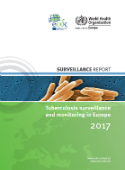Tuberculosis surveillance and monitoring report in Europe 2017

Download
In 2015, an estimated 323 000 new tuberculosis (TB) cases and relapses (incident cases) occurred in countries of the WHO European Region, equivalent to 35.5 cases per 100 000 population. Since 2000, TB incidence in the Region decreased. During 2006–2015, the average decline was 5.4% per year. As for 2011–2015 the decline slowed down to 4.3% per year, and continued to slow down further in 2015 by 3.3% compared to 2014. Yet, despite being the fastest decline in the world compared to other WHO Regions, there is a need for faster decline in TB incidence, if the Region is to meet the targets of End TB Strategy by 2035.
One in five multidrug-resistant TB (MDR-TB) cases globally was estimated to have occurred in the European Region in 2015. The alarmingly high rates of MDR-TB in most of the eastern European countries and central Asian countries represent one of the main challenges of TB control in the WHO European Region. In 2015, an estimated 16% of new cases and 48% of previously treated cases had MDR-TB, that accounts for an estimated 74 000 cases of MDR-TB.
The estimated 323 000 incident TB cases in the Region include 27 000 cases with HIV co-infection. In the reporting countries, of the 206 096 new and relapse TB patients notified 181 995 were screened for HIV (88.3%). A total of 16 380 TB cases were detected with HIV-positive status, which is 9.0 % of those tested. This is significantly higher than the 5.5% with HIV-positive status recorded in 2011, indicating that the absolute number of TB/HIV cases continues to increase in the Region from 11 652 to 16 380 during 2011–2015.
A new Roadmap to implement the TB Action Plan for the WHO European Region 2016–2020 was subsequently endorsed at the 65th session of the WHO Regional Committee in Vilnius, Lithuania on 14–17 September 2015. This Action Plan sets a Regional goal of preventing further spread of drug-susceptible and drug-resistant TB by achieving universal access to prevention, diagnosis and treatment in all Member States of the Region which, in turn, will contribute to the End TB Strategy aim of ending the TB epidemic. Under the TB Action Plan targets to be achieved by 2020 are: a 35% reduction in TB deaths, a 25% reduction in TB incidence rates and a 75% treatment success rate among MDR-TB patients.
As stipulated in the TB Action Plan, there is a need to scale-up rapid diagnosis, and ensure efficient and adequate treatment for all. To this end uptake and rational use of new diagnostic tests, new medicines and shorter treatment regimens shall be pursued in a people-centred model of care. Along using the existing tools, innovative approaches and research for new tools, such as a more efficient vaccine, and promotion of intersectoral and innovative, health system strengthening approaches to address inequities, are much needed.



